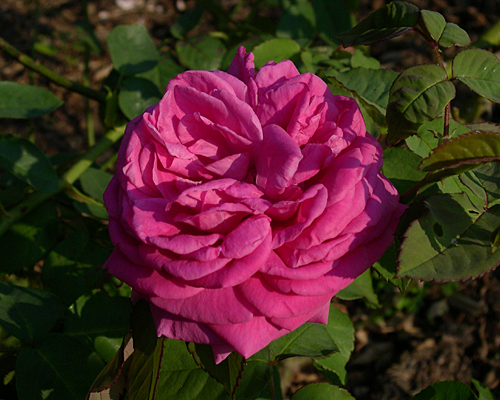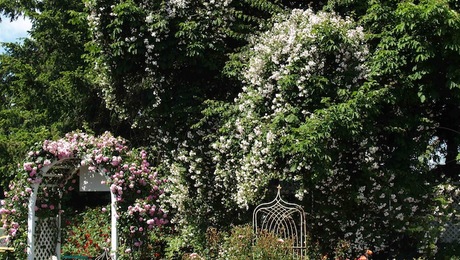As Americans moved west across their new country, many a rose traveled along in those Conestoga wagons tucked somewhere between the family clock and the frying pan used to make “Hoppin John.” Upon arrival at the new homestead, these roses were planted, watered, and left to grow under the same conditions those early settlers encountered. Over time their true names were forgotten, and they became known simply as “Grandma’s Red Rose” or “Aunt Sally’s Pink Climber.” Many survive today as “Found Roses” rustled by dedicated rosarians. Names like “Charleston Graveyard,” “Angles Camp White Tea,” and “Natchitoches Noisette” are as much a testament to the conditions they thrived under as to the locations where they were rediscovered.

Roses eventually found their way into almost every garden. Some were grown for their beauty and some for medicinal purposes, such as R. gallica officinalis, better known as “Apothecary’s Rose” for that very reason. Their ability to retain perfume in their dried petals was just another reason to tuck them amid the hollyhocks in the garden.
Rose hips became valued as a rich source of vitamin C and were carried by sailors on long voyages to prevent scurvy. As recently as World War II, rose hips were grown in Victory Gardens to replace the vitamin C normally found in citrus fruits, which were at that time unavailable in cooler climates. I would wager that the roses producing those hips were treated just like all the other plants in those hundreds of thousands of gardens grown as a badge of patriotism. Imagine if those Victory Roses needed complicated spraying and feeding programs. I suspect they would have been used more as compost than a source for vitamin C.
Fast forward to today, and my garden at home is a no-spray, no-chemical, no-irrigation-beyond-what-falls-from-the-sky garden, and much like the shoes of the cobbler’s children, my roses get little to no care. Roses from species to modern are left to thrive on their own. And they do. In fact, in time I’ve even noticed roses such as Mme. Isaac Pereire—a Bourbon rose that can be disease prone but that I love anyway because she bears blooms of stunning beauty and scent—has slowly built up her immune system and now rarely gets a disease.
Much like children who have to catch every cold in order to build up immunity, I feel roses mature in the same manner. Even my beloved Mme. Isaac is almost always without disease now that she has gone through adolescence. Perhaps we coddle our roses too much?
Fine Gardening Recommended Products

A.M. Leonard Deluxe Soil Knife & Leather Sheath Combo
Fine Gardening receives a commission for items purchased through links on this site, including Amazon Associates and other affiliate advertising programs.


















Comments
Paul, I appreciate the info about the lime & sulphur spray. I have not sprayed my roses this year (usually spray several times during the seasaon) and they have been quite healthy I have been wondering if it is the weather or if it is what you describe as their becoming more immune to diseases.
Naptowngal. Possibly a combination of both. I found when I stopped spraying it took about a year or two for my roses to become healthier on their own. What kind of weather are you having?
Log in or create an account to post a comment.
Sign up Log in